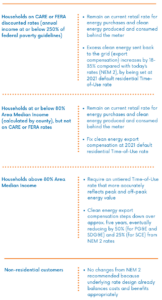Our Vision for California’s Net Metering Update
[Updated 11/10/2021, originally published 3/16/2021]
The California Public Utilities Commission (CPUC) is planning to update the state’s net metering policy by the end of 2021. Net metering is a foundational clean energy policy that allows customers with onsite solar to save on their electric bill by receiving a credit for the excess clean energy they send back to the grid. Yesterday, stakeholders filed more than 15 separate proposals for the design of the net metering successor tariff (known in shorthand as “NEM 3”). Much is at stake as the agency determines the future of onsite solar savings. As I wrote in January, Vote Solar proposed three overarching goals for the Golden State’s net metering update:
- Keep rooftop solar growing to fight climate change and build a safer, more resilient grid.
- Prioritize equity: bring rooftop solar + storage to more low-income families and disadvantaged communities.
- Make solar-charged batteries the industry standard for rooftop solar by 2030.
Now let’s dive into the specifics of what the successor tariff should look like to achieve those goals. To increase access for income-qualified families, we propose to maintain or increase compensation for excess clean energy sent back to the grid. A 2020 study by Lawrence Berkeley National Laboratories estimates that of all California investor owned utility residential solar adopters who connected their systems in 2019, only 20% had incomes at 80% of their Area Median Income or below, indicating that onsite clean energy deployment remains significantly higher for higher-income customers. By raising the value of exports for the lowest-income Californians who are on discounted rates, we are shortening the payback period for their investments to be more consistent with those on non-discounted rates, easing customers’ energy burden and reducing financial barriers to rooftop solar and storage.
To encourage many more California households to pair battery storage with their rooftop solar, we propose stronger price signals to general market residential consumers that sending their clean electricity back to the grid during off-peak (daytime) hours will reduce the value of their investment, and that they should store their excess clean energy for on-peak (evening) use. Requiring these customers to go on an untiered time-of-use rate will also encourage them to further reduce emissions by electrifying their homes and vehicles. The tariff changes we propose for these customers phase in over time so that the state’s distributed clean energy markets can plan and adjust, and would ensure that by approximately 2030, solar energy bill savings will align with its benefits to the grid, as measured by the Commission’s 2021 Avoided Cost Calculator (ACC).
Below is a table summarizing the primary elements of Vote Solar’s net metering successor tariff proposals, which are targeted to different categories of onsite clean energy customers. These proposals are specific to California; each state’s distributed clean energy landscape is different, with California far ahead of most states in deployment, approaching 10% of all investor-owned utility customers already having installed onsite clean energy.

Vote Solar’s successor tariff concepts were filed this Fall in two separate but complementary proposals. The first proposal, filed jointly with GRID Alternatives and Sierra Club, is aimed at increasing access for low-income customers, who are disproportionately communities of color and environmental justice communities. The second proposal, filed jointly with the Solar Energy Industries Association, proposes tariff design for general market residential and non-residential customers.
California cannot achieve its ambitious clean energy goals if policymakers suddenly and dramatically lower bill savings for those who choose to go solar, as the utilities will continue to demand.We trust that as CPUC Commissioners update net metering, they will recognize that keeping clean, distributed generation growing is essential for decarbonizing our economy, building a more reliable and resilient modern grid that can better withstand climate disasters, and giving more consumers the freedom to lower and stabilize their energy bills.

